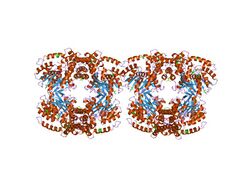Biology:Glycoside hydrolase family 4
| Family 4 glycosyl hydrolase | |||||||||
|---|---|---|---|---|---|---|---|---|---|
 Structure of the 6-phospho-beta glucosidase from Thermotoga maritima at 2.55 angstrom resolution in the tetragonal form with manganese, NAD+ and glucose-6-phosphate | |||||||||
| Identifiers | |||||||||
| Symbol | Glyco_hydro_4 | ||||||||
| Pfam | PF02056 | ||||||||
| Pfam clan | CL0063 | ||||||||
| InterPro | IPR001088 | ||||||||
| PROSITE | PDOC01027 | ||||||||
| SCOP2 | 1obb / SCOPe / SUPFAM | ||||||||
| CAZy | GH4 | ||||||||
| |||||||||
| Family 4 glycosyl hydrolase C-terminal domain | |||||||||
|---|---|---|---|---|---|---|---|---|---|
| Identifiers | |||||||||
| Symbol | Glyco_hydro_4C | ||||||||
| Pfam | PF11975 | ||||||||
| Pfam clan | CL0341 | ||||||||
| PROSITE | PDOC01027 | ||||||||
| SCOP2 | 1obb / SCOPe / SUPFAM | ||||||||
| CAZy | GH4 | ||||||||
| |||||||||
In molecular biology, glycoside hydrolase family 4 is a family of glycoside hydrolases EC 3.2.1., which are a widespread group of enzymes that hydrolyse the glycosidic bond between two or more carbohydrates, or between a carbohydrate and a non-carbohydrate moiety. A classification system for glycoside hydrolases, based on sequence similarity, has led to the definition of >100 different families.[1][2][3] This classification is available on the CAZy web site,[4][5] and also discussed at CAZypedia, an online encyclopedia of carbohydrate active enzymes.[6][7]
Glycoside hydrolase family 4 CAZY GH_4 comprises enzymes with several known activities; 6-phospho-beta-glucosidase (EC 3.2.1.86); 6-phospho-alpha-glucosidase (EC 3.2.1.122); alpha-galactosidase (EC 3.2.1.22); alpha-D-glucuronidase (EC 3.2.1.139).[8] 6-phospho-alpha-glucosidase requires both NAD(H) and divalent metal (Mn2+, Fe2+, Co2+, or Ni2+) for activity.[9]
External references
References
- ↑ "Conserved catalytic machinery and the prediction of a common fold for several families of glycosyl hydrolases". Proceedings of the National Academy of Sciences of the United States of America 92 (15): 7090–4. July 1995. doi:10.1073/pnas.92.15.7090. PMID 7624375. Bibcode: 1995PNAS...92.7090H.
- ↑ "Structures and mechanisms of glycosyl hydrolases". Structure 3 (9): 853–9. September 1995. doi:10.1016/S0969-2126(01)00220-9. PMID 8535779.
- ↑ "Updating the sequence-based classification of glycosyl hydrolases". The Biochemical Journal 316 (Pt 2): 695–6. June 1996. doi:10.1042/bj3160695. PMID 8687420.
- ↑ "Home" (in en). http://www.cazy.org/.
- ↑ "The carbohydrate-active enzymes database (CAZy) in 2013". Nucleic Acids Research 42 (Database issue): D490-5. January 2014. doi:10.1093/nar/gkt1178. PMID 24270786.
- ↑ "Glycoside Hydrolase Family 4" (in en). http://www.cazypedia.org/index.php/Glycoside_Hydrolase_Family_4.
- ↑ CAZypedia Consortium (December 2018). "Ten years of CAZypedia: a living encyclopedia of carbohydrate-active enzymes". Glycobiology 28 (1): 3–8. doi:10.1093/glycob/cwx089. PMID 29040563. https://hal.archives-ouvertes.fr/hal-01886461/file/Hehemann_2018_01.pdf.
- ↑ Mohapatra, Samar Ballabha; Manoj, Narayanan (2021-02-26). "Structural basis of catalysis and substrate recognition by the NAD(H)-dependent α-d-glucuronidase from the glycoside hydrolase family 4" (in en). Biochemical Journal 478 (4): 943–959. doi:10.1042/BCJ20200824. ISSN 0264-6021. PMID 33565573. https://portlandpress.com/biochemj/article/478/4/943/227832/Structural-basis-of-catalysis-and-substrate.
- ↑ "The gene glvA of Bacillus subtilis 168 encodes a metal-requiring, NAD(H)-dependent 6-phospho-alpha-glucosidase. Assignment to family 4 of the glycosylhydrolase superfamily". The Journal of Biological Chemistry 273 (42): 27347–56. October 1998. doi:10.1074/jbc.273.42.27347. PMID 9765262.
 |

